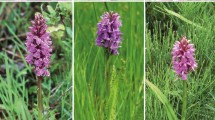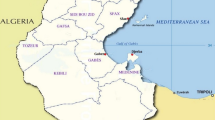Abstract
Enzyme polymorphisms have been widely used in aquatic plants since the 1980s. Studies on DNA polymorphisms are less numerous and a case-study using both methods on Scirpus is worked out. Along the unique freshwater tidal zone of the River Schelde (Belgium), clumps of Scirpus species are mostly scattered in small and fragmented locations on the dikes and mud flats. Most of these taxa are native S. triqueter, S. tabernaemontani or intermediate morphological forms. However, several cultivated strains of S. tabernaemontani have been introduced in recent years. Such ‘exotic’ strains have been planted to stabilize the muddy riverbanks and became well established and may perform better than the native hybrid complex. In order to determine the existing genetic diversity among these species and the possibility for genetic pollution, stems of 30 clumps from a series of locations along the tidal river were investigated for seven enzymes (SDH, PGM, EST, MNR, GOT, 6PGD and ME) and for markers at DNA level using random amplified polymorphic DNA's (RAPD) of 22 decanucleotides. Data analysis of the allozymes and of the amplified DNA fragments enabled us to classify unambiguously the different Scirpus taxa. Direct evidence of hybridization between S. triqueter and S. tabernaemontani could not be obtained, but the putative hybrids are genetically intermediate or close to S. triqueterwhen considering the DNA polymorphism. The introduced clones of S. tabernaemontani consisted of at least three groups of genotypes of which one was very related to the native ones. The escaped clumps could be assigned to a third introduced but less-related strain.
Similar content being viewed by others
References
Coops, H., 1996. Helophyte zonation: impact of water depth and wave exposure. PhD thesis, Katholieke Universiteit Nijmegen: 150 pp.
De Greef, B. & L. Triest, 1999. The use or RAPD for hybrid detection in Scirpus from the river Schelde (Belgium). Molecul. Ecol. 8: 379–386.
DeFilipps, R., 1980. Scirpus L. In Tutin et al. (eds), Flora Europaea 5. Cambridge Univ. Press: 277–280.
Largiader, C. & A. Scholl, 1996. Genetic introgression between native and introduced brown trout Salmo trutta L. populations in the Rhone river basin. Molecul. Ecol. 5: 417–426.
Madeira, P., T. Van, K. Steward & R. Schnell, 1997. Random amplified polymorphic DNA analysis of the phenetic relationships among world-wide accessions of Hydrilla verticillata. Aquat. Bot. 59: 217–236.
Murray, M. & W. Thompson, 1980. Rapid isolation of high molecular weight plant DNA, Nucleic Acids Res. 8: 4321–4325.
Nei, M., 1978. Estimation of average heterozygosity and genetic distance from a small number of individuals. Genetics 89: 583–590.
Novak, S. & R. Mack, 1993. Genetic variation in Bromus tectorum (Poaceae): comparison between native and introduced populations. Heredity 71: 167–176.
Piquot, Y., P. Saumitou-Laprade, D. Petit, P. Vernet & J. T. Epplen, 1996. Gentopyic diversity revealed by allozymes and oligonucleotide DNA fingerprinting in French populations of the aquatic macrophyte Sparganium erectum. Molecul. Ecol. 5: 251–258.
Rogers, J. S., 1972. Measures of genetic similarity and genetic distances. Studies in Genetics. Univ. Texas Public. 7213: 145–153.
Sambrook, J., E. F. Fritsch & T. Maniatis, 1989. Molecular Cloning: a Laboratory Manual, 2nd edn. Cold Spring Harbor Laboratory Press, New York.
Swofford, D. & R. B. Selander, 1981. BIOSYS-1: a Fortran program for the comprehensive analysis of electrophoretic data in population genetics and systematics. J. Heredity 72: 281–283.
Triest, L., 1989. Electrophoretic polymorphism and divergence in Najas marina L. (Najadaceae): molecular markers for individuals, hybrids, cytodemes, ecodemes and conservation of genetic diversity. Aquat. Bot. 33: 301–380.
Triest, L., 1991. Isozymes in water plants. Opera Botanica Belgica 4, Nat. Botanic Garden, Meise: 269 pp.
Triest, L., 1992. The role of isozymes in studies of plant populations: several considerations of data obtained in water plants. Belg. J. Bot. 125: 262–269.
Triest, L., 1993. Problems created by excessive macrophyte growth in tropical freshwater ecosystems and strategies for control. In Tilzer, M. & M. Khondker (eds), Hypertrophic and Polluted Freshwater Ecosystems: Ecological Basis for Water Resource Management. Proc. Int. Symp. Limnol., 25–28 November 1991. Dep. Bot., Dhaka Univ., Bangladesh: 137–153.
Triest, L., B. De Greef, S. Vermeersch, J. Van Slycken & E. Coart, 1999. Genetic variation and putative hybridization in Salix alba and Salix fragilis: evidence from allozyme data. Plant Syst. Evolut. 215: 169–187.
Van Oorschoot, M. & J. Verhoeven, 1990. Wetlands for the puri-fication of water. The Utrecht Plant Ecology News Report 11, Postacad. Onderwijs Natuurwetenschappen, Univ. Utrecht: 269 pp.
Waycott, M., 1995. Assessment of genetic variation and clonality in the seagrass Posidonia australis using RAPD and allozyme analysis. Mar. Ecol. Prog. Ser. 116: 289–295.
Weeda, E., R. Westra, C. Westra & T. Westra, 1994. Nederlandse Oecologische Flora: wilde planten en hun relaties 5, Lecturis BV, Eindhoven: 400 pp.
Author information
Authors and Affiliations
Rights and permissions
About this article
Cite this article
Triest, L., De Greef, B. The use of isozymes and PCR-based DNA polymorphism in aquatic weed management: a case-study on introduced and native clones of a hybrid complex . Hydrobiologia 415, 77–85 (1999). https://doi.org/10.1023/A:1003885403429
Issue Date:
DOI: https://doi.org/10.1023/A:1003885403429




